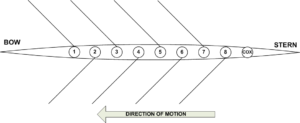TYPES OF ROWING
SWEEP: or sweep-oar rowing, each rower has one oar, held with both hands. This is generally done in pairs, fours, and eights. Each rower in a sweep boat is referred to either as port or starboard, depending on which side of the boat the rower’s oar extends to.
SCULLING: each rower has two oars (or sculls), one in each hand. Sculling is usually done without a coxswain, in quads, doubles or singles. The oar in the sculler’s right hand extends to port, and the oar in the left hand extends to starboard.
COMMON TERMS
SHELL: Another term for a boat, specifically, a boat used in racing.
BOW: End of the boat closest to the direction of travel. See diagram. Also can be used to refer to one-seat, or in conjunction with either four or pair. Bow-four refers to seats four through one. Bow-pair refer to seats two and one.
STERN: End of the boat farthest from the direction of travel. See diagram. Also can be used in conjunction with either four or pair. Stern-four refers to seats eight through five. Stern-pair refer to seats eight and seven.
PORT: Side of the boat to the coxswain’s left and to the rower’s right. (See diagram seats 2,4,6 and 8). The oar sticks out to a port-rower’s right.
STARBOARD: Side of the boat to the coxswain’s right and to the rower’s left. (See diagram seats 1,3,5,and 7).
BLADE: The face of the oar that pushes against the water.
OARLOCK: Square latch to hold the oar and provide a fulcrum for the stroke against the rigger.
RIGGER: An apparatus on the side of the boat to provide a fulcrum for the lever (oar).
FOOT STRETCHER: Part of the boat where the shoes are attached and where the rower pushes his legs on the drive.
SKEG: Fixed plastic piece beneath boat for stabilization. The rudder is mounted on it. Also called a fin. The skeg (incl. rudder) can break off in shallow water. It can also break off by hitting the dock when putting the boat in the water or taking it out. Please be careful!
SLIDE: The tracks in which the seat rolls.
BACK STOP: A small block on the bow end of the slide, which holds the seat on track.
FRONT STOP: A small block on the stern end of the slide, which holds the seat in place.
RUDDER: A little fin on the bottom of the boat that the coxswain can control to steer the boat.
COXSWAIN: A very important member of the crew. Their primary job is steering but they also provide feedback during races about location on the course, relative position to other crews , and stroke rate per minute. They serve as an in-the-boat coach during races.
COX BOX: A small electronic device which aids the coxswain by amplifying his voice and giving him a readout of various information, such as stroke ratings.
STROKE: One full motion to move a boat. Consists of the catch, drive, finish, and recovery.
CATCH: The part of the stroke where the oar enters the water.
DRIVE: Part of the stroke where the rower pulls the blade through the water using legs, back and arms to propel the boat.
LEG DRIVE: Term used for driving the legs against the foot stretchers on the drive.
LAYBACK: Term for how much you lean back at the finish.
FINISH: Part of the stroke after the drive where the blades come out of the water. The rower removes the oar from the water, by first pushing downward then away with the hands.
RELEASE: Another term for finish.
RECOVERY: Part of the stroke where the rowers comes back up the slide slowly towards the catch. The oar is pushed away from the body by extending the arms, reaching the body forward and compressing the legs so the shin is vertical, preparing for the next Catch. The oar should not drag on the water.
FEATHERING: Rotating the oar in the oarlock so that the blade is parallel to the surface of the water.
SQUARING: Rotating the oar in the oarlocks so that the blade is perpendicular to the water.
STROKE RATE: How fast a stroke is being taken, in terms of strokes per minute.
SET (the boat): command to balance the boat.
CATCHING A CRAB: slang; getting an unexpected tug or jerk on your blade. The blade gets “caught” in the water making the oar handle fly up or towards you or even behind you.
CHECK: the interruption or braking of the boat’s forward momentum. Things that cause check during a race include poor bladework, rushing the slide, and hitting the front stops.
ERG (ERGO/ERGOMETER/ERG MACHINE): A rowing machine designed to simulate the actual rowing motion; used for training and testing.
REGATTA: An organized crew race.
HEAD STYLE RACING: is done in the fall and can be done on river, where there are twists and turns. The shells do not line-up, but race against the clock, after starting one behind the other. You need not pass another crew to beat it, but if you pass someone that started in front of you, you have surely beat their time. The race distance is usually 3 miles long.
SPRINT RACING: is done with the crews starting with the bow of their shells even a racing parallel to each other. They start together, and the first crew to cross the finish line wins. We do this racing in the spring. On the collegiate level and internationally, the race distance is 2000 meters. Master rowers (age 27 and older) race 1000 meters.
NOVICE: a rower in their first 12 months of rowing. Since it takes most people a while to refine the basics of rowing and racing, they can row against others of similar experience level.
